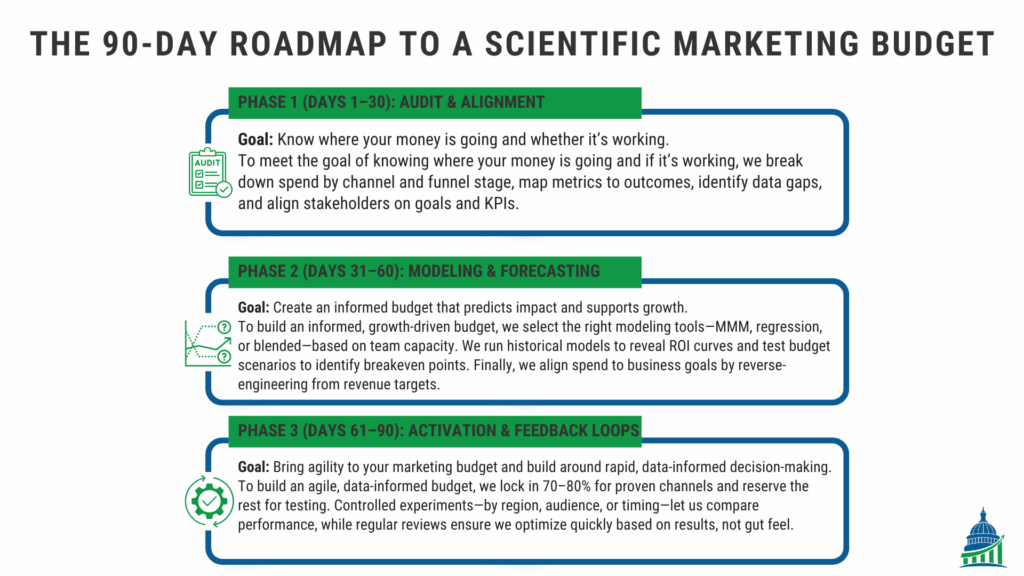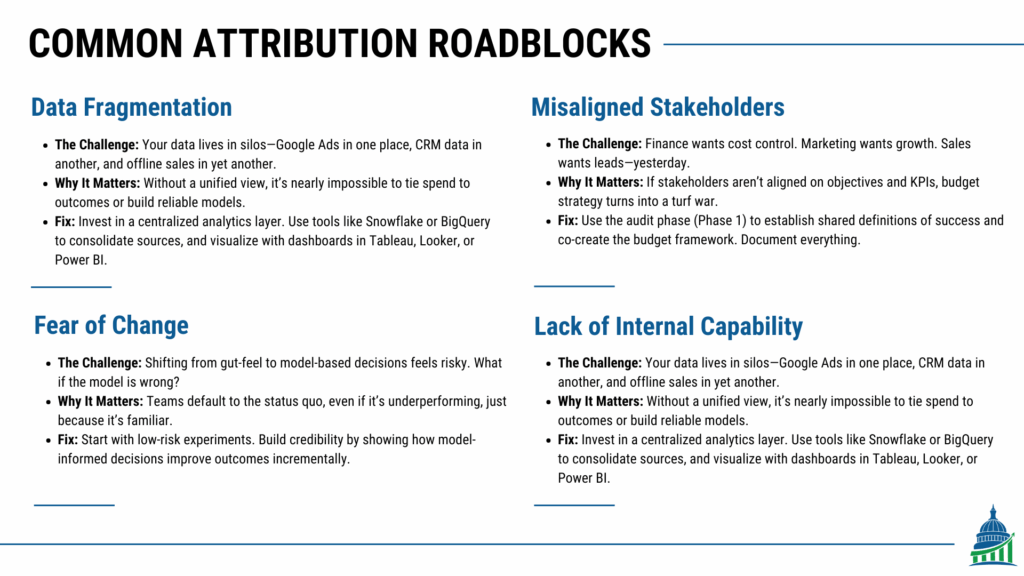As an American-made manufacturer, you've relentlessly optimized your production line, yet three hidden wastage points beyond your view still threaten your profitability and even your business survival.
Read MoreA few years ago, I was consulting with a CMO responsible for a multi-million dollar marketing budget. When campaign performance dipped, their approach was all too familiar: “Do we think this is working? Let’s throw an additional $5,000 at it and see if it performs better.” But that quick-fix mindset raised deeper questions—what does “better” actually mean? And how do we know if $5,000 is too much or too little?
This wasn’t a startup scraping by. It was a well-funded operation with big goals, but still flying half-blind when it came to spend decisions. And that’s the real takeaway: whether your marketing budget is $50,000 or $5 million, the size doesn’t exempt you from the need for a structured, scientific process.
Most marketing leaders know the feeling: you’re staring at a spreadsheet, trying to rationalize budget numbers based on last year’s performance, a few gut instincts, and some best guesses. The stakes are high, the data is murky, and yet—decisions have to be made.
It doesn’t have to be this way.
In this article, you’ll learn how to replace guesswork with grounded strategy. I will walk you through a 90-day roadmap to build a scientific marketing budget—one that aligns spend with outcomes, improves ROI, and turns your marketing plan into a measurable growth engine.
A scientific budget is not about spreadsheets filled with fancy formulas—it’s about applying the rigor of experimentation and analysis to your marketing decisions. Instead of starting with arbitrary numbers or copying last year’s plan, scientific budgeting begins with questions: What outcomes are we driving? What levers move those outcomes? How can we measure impact and adapt in real-time?
Here’s what sets a scientific budget apart:
The difference is measurable. Companies using data-driven budgeting see 20–30% higher marketing ROI. And marketers who align budgets to funnel-stage attribution outperform competitors by 37%.

Transitioning to a scientific budget doesn’t require a complete overhaul—it requires a structured, phased approach. Over the next 90 days, your goal isn’t perfection; it’s clarity, alignment, and traction. Here’s how to do it:
Goal: Know where your money is going and whether it’s working.
Goal: Create an informed budget that predicts impact and supports growth.
Goal: Bring agility to your marketing budget and build muscle around rapid, data-informed decision-making.

Even with the best intentions, transitioning to a scientific marketing budget isn’t always smooth. Most teams encounter one or more of these roadblocks—knowing they’re coming is half the battle.
The Challenge: Your data lives in silos—Google Ads in one place, CRM data in another, and offline sales in yet another.
Why It Matters: Without a unified view, it’s nearly impossible to tie spend to outcomes or build reliable models.
Fix: Invest in a centralized analytics layer. Use tools like Snowflake or BigQuery to consolidate sources, and visualize with dashboards in Tableau, Looker, or Power BI.
The Challenge: Finance wants cost control. Marketing wants growth. Sales wants leads—yesterday.
Why It Matters: If stakeholders aren’t aligned on objectives and KPIs, budget strategy turns into a turf war.
Fix: Use the audit phase (Phase 1) to establish shared definitions of success and co-create the budget framework. Document everything.
The Challenge: Shifting from gut-feel to model-based decisions feels risky. What if the model is wrong?
Why It Matters: Teams default to the status quo, even if it’s underperforming, just because it’s familiar.
Fix: Start with low-risk experiments. Build credibility by showing how model-informed decisions improve outcomes incrementally.
The Challenge: Your team isn’t trained on MMM or doesn’t have a dedicated data analyst.
Why It Matters: Without the right skills or tools, even the best strategy can stall.
Fix: Consider fractional support, analytics consultants, or lightweight tools like Robyn or Google’s Meridian. Build capability over time rather than waiting for the “perfect” setup.
Each of these roadblocks is solvable—and planning for them up front increases your odds of success dramatically.
The marketing teams that win in today’s landscape aren’t necessarily the ones with the biggest budgets—they’re the ones that know how to allocate those budgets with precision. Over the past 90 days, you’ve learned how to move from chaos to clarity, from gut-feel to grounded decision-making.
A scientific marketing budget is more than a spreadsheet—it’s a mindset. One that prioritizes alignment, experimentation, and agility. It connects every dollar to a purpose, every tactic to an outcome, and every campaign to a learning opportunity.
The biggest takeaway? Clarity isn’t just a nice-to-have. It’s a competitive advantage. In a world where most marketers still rely on guesswork, your ability to budget scientifically sets you apart. It empowers you to act faster, waste less, and scale what works.
Start small. Build momentum. And remember: the path to smarter marketing spend is paved with better questions, cleaner data, and a process that evolves with you.
If you’re ready to take the next step, download our 90-Day Marketing Budget Planner to turn insight into action.
Most marketing budgets are based on historical spend or executive intuition rather than performance data. This leads to inefficiencies, missed growth opportunities, and misaligned goals. A scientific approach eliminates this by using attribution, modeling, and feedback loops to inform decisions.
Start by identifying your key business objectives (e.g., revenue, lead volume, CAC). Then reverse-engineer your budget using performance data and predictive modeling to determine how much spend is needed to hit those targets.
Tools like Robyn (Meta), Google’s Meridian, and platforms like Tableau, Snowflake, or Looker help marketers model performance, centralize data, and visualize insights. These tools support scientific budget creation and ongoing optimization.
With a structured plan, you can build a scientific marketing budget in 90 days. Our roadmap includes three phases: Audit & Alignment, Modeling & Forecasting, and Activation & Feedback Loops.
Clarity enables faster, smarter decisions. By tying every dollar to a measurable outcome, marketers gain the agility to pivot, scale what works, and eliminate waste—giving them a competitive edge over guesswork-based teams.
As an American-made manufacturer, you've relentlessly optimized your production line, yet three hidden wastage points beyond your view still threaten your profitability and even your business survival.
Read MoreBreak Open the Black Box—Unlock the Power of Sales Attribution for American-Made DTC Brands.
Read MoreUnderstanding who is likely to purchase allows you to optimize your efforts. How do you do this?
Read More